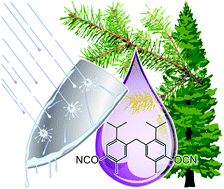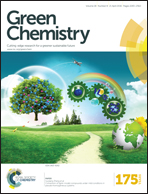Sustainable hydrophobic thermosetting resins and polycarbonates from turpentine†
Abstract
Carvacrol is a renewable phenol that can be derived from abundant components of pine resin. To demonstrate the utility of carvacrol for polymer applications, a bisphenol was synthesized from carvacrol and converted to both a cyanate ester resin (CarvCy) and polycarbonate. A cured resin disk prepared from CarvCy exhibited a Tg of 224 °C and a water uptake of only 0.7% after being immersed in 85 °C water for four days. The wet Tg of the material was only 3 °C lower than the dry Tg showing that the cured resin was virtually unaffected by exposure to hot water. Despite the presence of aliphatic groups on the aromatic rings, the cured resin exhibited good thermal stability with only 5% weight loss at 390 °C. The polycarbonate prepared from carvacrol had Mn = 10 200, Mw/Mn = 1.60, Tg = 119 °C, and even better thermal stability than the cyanate ester with 5% weight loss observed at 421 °C. The results provide compelling evidence that the sustainable phenol carvacrol can be used as a platform molecule for the generation of high performance polymers with exceptional properties.


 Please wait while we load your content...
Please wait while we load your content...